main: January 2009 Archives

Kawara Has Not Dated
Who would have thought that On Kawara would now look like a major artist? His work has a certain Dada purity. One of the things Kawara does, has done, and continues to do - since Jan. 4, 1966 -- is paint the date wherever he is, in white on a monochromatic ground. Of course, it gets more complicated. The date is not painted every single day. Furthermore, some days he paints the date two or three times. I assume that whoever buys a date painting is informed if his or her proud possession is singular or not. Does a "bachelor" date cost more than a one-of-three? Can some collector commission a particular date? Somehow I doubt it.
Because of Kawara's strict subject matter and long-term commitment, questions like these can loom. And, by the way, what is the difference between focus and commitment, and then between commitment and obsession?
Offhand, I would say focus is fine; obsessiveness, unless you are talking about an Outsider artist, is generally seen as negative, right? On some days, I would reverse the terms. And commitment? Commitment, at the risk of being Existentialist and/or political, is probably perfect, at least for Kawara.
* * *
My inspiration for what follows is "On Kawara - One Million Years" now at David Zwirner (525 W. 19th St.) until Feb. 14. No "paintings" are on view. All you will see are two cases displaying books of dates, a freestanding recording booth, recording paraphernalia, and the "product" being created before your very eyes - or rather ears: a row of CDs. Volunteers inside the booth read dates; outside the booth a technician takes care of the technicalities.
"It is believed that 2,700 CDs will be needed to complete the readings of One Million Years [Past] and One Million Years [Future]," or so saith the press release, which also tuned me into Kawara's Pure Consciousness: seven date paintings (JAN. 1 - JAN. 7, 1997) "exhibited in kindergarten classrooms around the world."
The Paintings, the Brand
Although Kawara works in several serial formats, there is still the branding issue. Kawara has claimed dates and, in terms of art, he "owns" them. He also has rights to his elegant way of presenting the dates as paintings. And as sound pieces.
When does a subject or a style become a logo? Or, forgive me, a brand? Is "branding" bad? Picasso, throughout his many style shifts, always had his hand as a brand. Duchamp branded his own marriage of the mystical, the intellectual and the droll, whereas Picabia branded change itself, perhaps to his own detriment. We remember all too well when Magritte almost sank his own ship when he went temporarily mad and tried to become a latter-day Impressionist.
Let's face it, art is a trap, at least when it becomes a career. Are there any alternatives? Art as a calling? Art as philosophical or spiritual investigation? Art as a vehicle of self-transformation?
In terms of the infamous - but now classic - "paintings", Kawara always uses the most ordinary looking numerals possible or, according to some accounts, the most typical typography in force wherever he is. It could be New York, Paris, Berlin. Or wherever.
He is not doing an Ed Ruscha attempt at wit or graphic-design trope. If anything, Kawara is anti-design, which is why he is sometimes thought of as a Minimalist. Or is he a Conceptualist? If the latter, why does he bother hand-painting his dates?
Furthermore, according to curator Lynne Cooke's brief (upon the occasion of "One Thousand Days, One Million Years," 1993, at Dia):
When not on view each painting is housed in a handmade cardboard box which also contains a clipping from a local newspaper from the city in which the artist was resident on that date. Mostly, the title for a work is derived from either a headline or a caption found on the accompanying newspaper clipping.
I do not remember seeing titles derived from newspaper clippings - but Artopia can't be everywhere at once. Also, just think what different works these would be if the clippings were always shown with the paintings? Probably not a good idea. But please, show us one such matchup and a handmade cardboard box. Viewers have a right to know.

Although these juicy bits of information add some grounding to the paintings, what could be more ordinary than the date? Kawara claims his subject is consciousness. But isn't that the real subject of all art? Isn't that a bit grand? Whereas, time...well, time is more down to earth.

All the Time in the World
What is the date? Every day it changes, but it is always the date. You read it, but you don't see it. It is quotidian. It is cosmic. The next day the signifier of the previous day is always out of date. But is the date a marker that stands for time? Or because it changes so precisely -- every 24 hours, all at once at midnight, and not by degrees -- is it somehow timeless? Could we have a date begin at dawn instead? Or at noon? Or at 3:26 p.m.?
Once you get the idea that dates and calendars are simple-minded, socially generated constructs - even those based upon astronomy -- you may become more disoriented then you want to be. Time is slippery.
The Chinese calendar, the Hebrew calendar, the Islamic calendar, and the much newer Hindu (Indian) calendar do not match up to the European (Gregorian) calendar that the Japanese-born Kawara, as far as I know, has always embraced, at least since living in the United States. "Other" calendars have different starting points in terms of year 1 (or in the three Mayan calendars, year 0), but most in one way or another try to factor in the lunar.
Should the Artopia calendar be strictly lunar?
I have long included the constantly updated image of the phase of the moon on my computer sidebar in case I decide to go sailing, surfing, clam-digging, or deep-sea fishing (or marauding), thinking this was a good way to keep track of tides. Wrong again. Tidal "predictions" involve calculations of moonrise and sunrise and, I think, local conditions and topography. So forget the moon. I now have a shortcut to a local-tides chart and am seriously contemplating investing in an analog surfer-clock for my sidebar.
And along with other synodic-cycle calendars, we can also forget an Artopia calendar based on the appearance of Venus over Long Island -- although I love the idea of a calendar based upon the evening star. Synodic cycles are determined by the time it takes for a celestial object to reappear at the same point in the sky relative to the sun as observed from earth.
The Artopia calendar is as complicated as the Mayan. The Mayans - who really did invent zero - used three calendars simultaneously. One was an agricultural calendar of 365 days, with 18 months and five extra days. Another, the sacred calendar of 260 days. There were 13-day weeks and 20-day weeks.
Needless to say there are various art-world calendars that also must be coordinated and integrated. Is it any longer the case that the art season begins on Labor Day and ends July 4? Art is virtually global. Art never sleeps.
Here is today's Artopian posting date using various calendars:
Gregorian (New Style)
2009-01-26 (Mon., Jan. 26, 2009)
Ordinal Calendar
2009-026
Week Date (ISO commercial calendar)
2009-W05-1
Julian (Old Style)
2009-01-13 (Mon. Jan.13,2009)
Islamic (Moslem)
1430-01-29 (Muharram 29, 1430)
Hebrew (Jewish)
5769-11-01 (Shevat 1, 5769)
Mayan Long Count
12.19.16.0.15
Mayan Haab
--15-18 (18 Muan)
Mayan Tzolkin
--15-9 (9 Men)
French Revolutionary
0217-05-07 (De'cade II Septidi Pluvio^se 217)
Old Hindu Solar
5109-10-12 (Makara 12, 5109)
Old Hindu Lunar
5109-11-01 (Magha 1, 5109)
Achelis World Calendar
2009-01-26 (Thursday, January 26, 2009)
Coptic
1725-05-18 (Tubah 18, 1725)
Ethiopian
2001-05-18 (Ter 18, 2001)
Jalaali
1387-11-07 (Bahman 7, 1387)
Japanese Traditional "Kyureki" with CE
2009-01-01 (Senkachi, Mutsuki 1, 2009)
chronological Julian day number (JD)
2454858
chronological modified Julian day number (MJD)
54857
Lilian day number (LDN)
155698
Here are fully operative calendar converters (and explanations!) http://www.fourmilab.ch/documents/calendar/
Once you become aware of the multiple "objective" calendars now in force worldwide, it is not so shocking that Prime Minister Nehru had a reason for backing Elizabeth Achelis's looney World Calendar. India needed one calendar. In 1953, there were at least 30 different calendars being used in his country, the residue of clans, castes, principalities, and long-gone conquerors, fledgling nations, and even city-states. Each calendar was sacred, making any kind of industrial or social coordination nearly impossible.
One Calendar, One World?
What is obsessive-compulsive Achelis's World Calendar? It allows Christmas, your birthday, or whatever to fall on the same day every year through the judicious use of intercalary or "leap" days. And what benefit is this? Well, to begin with you can use the same calendar every year. Saves paper and trees. Why was its use defeated at the U.N.? Religionists opined that the required intercalary days interfered with the strict observance of a Sabbath every seven days as decreed by the Bible and the Qur'an.
In any case, now that we are digitally global, shouldn't we all be on Greenwich Mean Time? Railway Standard was started in 1840 so the Brits could coordinate their trains. The U.S. did not have a standardized time until noon, Nov. 18, 1883, but even so there were holdouts. Detroit, for instance, kept its local time until 1900.
But using British Mean Time or Railway Standard or the computer time called Unix -- counting seconds since noon Jan. 1, 1970 UTC (Coordinated Universal Time), how can I know when it is morning in Moscow, or Sydney; or lunchtime in Prague? Uh-oh. More coordination required!
But need we limit ourselves, like On Kawara, to Western Time - i.e., Pope Gregory's calendar of 1582? The truth of it is that if we can agree upon one calendar for all to coordinate what apparently needs to be synchronized -- elections, balls, train schedules, dinner parties, beach dates, invasions of Middle Eastern countries -- we can then simultaneously, but totally consciously and perhaps playfully, employ as many different calendars as we fancy: days can change at noon instead of midnight, years can start with the first Artopia entry or the Founder's Birthday, weeks can be ten days or five, or can alternate; months can be of any length --- April twice as long as December, for instance.
The personal and largely unconscious calendars and time systems we carry around in our heads may then see the light of day: curtain time, Oscar time, World Series time, play time, down time, Swing Time, lunchtime, dream time, time off for good behavior.
And then we can begin counting backwards, as at a liftoff. There's always the Big Countdown, but let's not go there.
FOR AN AUTOMATIC ARTOPIA UPDATE WITH EACH NEW ESSAY PLEASE REQUEST FROM perreault@aol.com
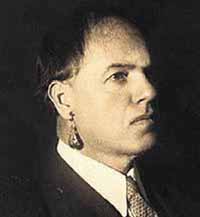
Life Is a Gas
David Burliuk was a living, breathing art paradox. At first glance, his life was more interesting than his art. Or was his life, rather than his paintings, his real art? There's an intriguing exhibition honoring him at New York's Ukrainian Museum, 222 E. 6th Street, to March 1. The exhibition, which originated at the Winnipeg Art Gallery, is entitled "Futurism and After: David Burliuk 1882-1967."
Burliuk is the nearly forgotten Zelig of art history. Born in the Ukraine, as a young man he high-tailed it to Munich and became a member of the Blue Rider group (1910), which as every art student knows included our hero Wassily Kandinsky.
Certainly this association sent Burliuk on his way toward abstraction, but, alas, it also sealed what I see as a deadly relationship to the folkloric -- the Slavic folkloric being the worst of all such obsessions. Artopia even dislikes Marc Chagall and certainly does not countenance any artwork that depicts dancing Cossacks. The founder of Artopia had a Polish grandmother.
Under normal circumstances this might provide an opening to discuss the current gas controversy between Russia and Ukrainia, but like everything Slavic it is far too complicated to fathom. It is not just Gazprom versus Naftogaz.
Ukrainia, according to Moscow, has been siphoning Russian gas from the pipelines that cross its borders, and therefore in retaliation was denied the passage of the same amount of gas they are accused of stealing. And then all gas was stopped. That means factories dependent upon Russian gas were being closed in Prague and other cities at the other end of the pipelines. Just to punish Kleptokrainia?
On the other hand, the Russian Bear -- strapped for funds because of the recession-driven drop in demand for all oil and gas -- has more than doubled the price of its natural resource and does not like the idea that Ukrainia might join NATO. At this writing, outside E.U. observers will be put in place to help resolve the "dispute." Nevertheless, the New York Times reports are muddled and repetitive. Truly, if you make a muddle that no one can understand, you can do what you want.
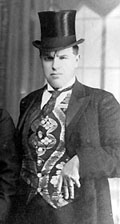
A Patchwork Vest
Back in time -- and back in pre-Stalinist USSR -- Burliuk became a leading light of Russian Futurism, among other things initiating art performances called "poezoconcerts" now represented only by handbills and a few, very rare, very fuzzy photographs. Then after spreading the word to Siberia, it was a hop, skip and jump to Japan, where he became the major influence on Japanese Futurism (1920-1922).

Did we ever study Japanese Futurism? Where has it been all of these years? Thanks to this sudden interest in Burliuk, the spotlight can now move to the Sanka (Third Section) group, not named after a brand of instant coffee (which did not yet exist) but after a quasi-mythic "wandering, mountain-outcasts" subculture of Japan. This was followed by the Group MAVO (1923-25), which initiated cross-dressing art performances - men in women's shoes! -- and like Sanka showed their paintings and assemblage in department stores in order to connect art and life. Check out on YouTube part of the DVD called David Burliuk and the Japanese Avant-garde.
Burliuk initiated the first exhibition of new Russian art in Japan, which included works by Malevich and Tatlin (both comrades of his). Burliuk was quite a character. Of the 473 works by 28 artists, 150 were by himself.
And then he and his family (his wife Marusia and two young sons) landed in New York during the Great Depression where -- contrary to the idea that he may have deserted the USSR to escape the Communists -- he worked from 1923 to 1940 as the art editor and proofreader for Russian Voice, a Communist newspaper. And this was when he was promoting what he called Radio-Style! And publishing a magazine called Color & Rhyme, which I myself would love to see.
Paradoxically, also at the Ukrainian Museum until Jan. 11 was
"HOLOMOR: Genocide by Famine," which documented what both the U.N. and the E.U. officially recognize as Stalin's intentional famine (1933-34), inflicted mainly on the collectivization-resistant Ukrainian farmers. According to recent estimates, seven to 10 million peasants died.
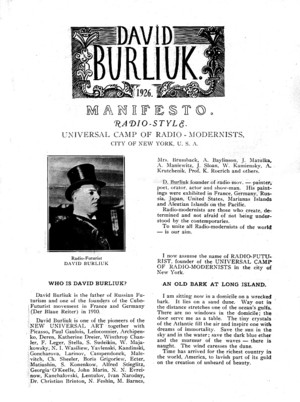
In Homage to the Invisible
Burliuk begins his 1926 Radio-Style manifesto by answering his own question: WHO IS DAVID BURLIUK? He is
...the father of Russian Futurism and one of the founders of the Cubo-Futurist movement in France and Germany...David Burliuk is on of the pioneers of the NEW UNIVERSAL ART... I now assume the name of RADIO-FUTURIST, founder of the UNIVERSAL CAMP OF RADIO-MODERNISTS in the City of New York.
If this wasn't enough, In 1941, burly Burliuk moved to Hampton Bays, Long Island, where he was the ringleader of the Hampton Bays Group, which included Rafael and Moses Soyer, Milton Avery, and Arshile Gorky. Whatta guy.
The Ukrainian Museum is in Little Ukrainia, now imbedded in the East Village. A few blocks away, at the 24-hour actor, artist, poet, student hangout Veselka on Second Avenue and 9th Street, you can still sample tasty Slavic staples such as pierogi, blintzes, borscht, and kielbasa.
But before you chow down, your art duty requires you to see the ink-on-cardboard portrait of Burliuk by Gorky (1930), a bust of him by Chaim Gross, and a bust of Marusia Burliuk by Isamu Noguchi. You can also admire Burliuk's garish, cubistic patchwork vest; a case featuring seven of his trademark single-drop earrings, and his glass eye; in another room there is a display of his easel, his paint brushes, his paint box and pallets.
And the paintings? They are all over the place. One of the problems is that they are all from the artist's estate, i.e., borrowed from his granddaughter. A bigger net and a sharper curatorial eye would have improved the show.
Outstanding is his Squares, a small, totally abstract paint from 1910. But I also liked Man With Two Faces (1912). Harlem River (1924) is his Radio-Style masterpiece.
David Burliuk, Harlem River, 1924 Slugging my way through the folkloric and big-face Socialist Realist pap and Neo-Impressionism, the next real knockout is the large Children of Stalingrad (1944), with portraits of Lenin and Stalin. Oddly enough, both the Neo-Romantic portrait of his son Nicholas (1942) and Marusia (1965) are quite wonderful. I was also charmed by Burliuk's effort to repaint van Gogh chestnuts. 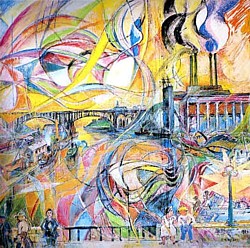
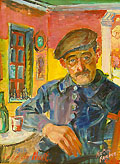 David Burliuk, Cafe de Nuit, 1949
David Burliuk, Cafe de Nuit, 1949
I do think, however, that there is a bigger, better case to be made for Burliuk. He was so uneven that I immediately began thinking I had better weed out my own paintings now in storage and many old poems that should never see print. Burliuk, the enthusiast, the promoter, the clown, was not a good critic or curator of his own work.
Even a cursory Google search reveals some paintings that deserve greater visibility. He needs to be better packaged. In any further investigation of Burliuk loans from Russia, although they might be difficult, will be essential.
But would downplaying his folkloric trope -- in play even when he was painting the locals of Hampton Bays and North Sea -- would we be denying him, betraying him? I don't think so. In truth, art is made by art history as much as by artists. Art history is not neutral.
Here are some Burliuks that are not in the exhibition:
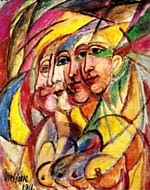
Heads, 1911. Stolichny Bank, Moscow
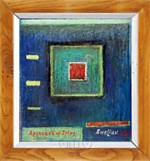
Approach of Spring, 1913
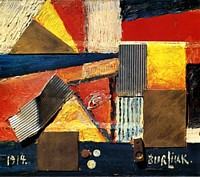
Collage, 1914. The Russian Museum, St. Petersburg

Portrait of Kamensky, N.D. [Russian Futurist painter, poet, and aviator]
The great thing about Burliuk, as limited as his talents may eventually turn out to be, is that his career reminds us of a time when some artists were determined to be rambunctious and free.
Everyone is now allowed to wear patchwork velvet vests, single chandelier earrings, and even women's shoes, but that is not enough.
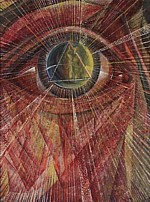
Eye-of-God, N.D.
So, since this is Artopia, I will end on an upbeat note with another quote from Burliuk's Radio-Style manifesto. Here in its entirety is a section called THE PRESIDENT OF THE WORLD'S ESTHETICS:
The Radio-Epoch - is the epoch of Cosmopolitanism. The voice of a song sung in Chicago is now heard in Australia and in the Steppes of Russia. The moment is not far distant when all the inhabitants of the earth will listen all at once to the declamations of the GREAT.
The President of ESTHETICS of all the world has already been elected. But he himself is not yet aware of it. Perhaps - it is you - you who are reading these lines? A palace of transcendent beauty is already prepared for you.
Life has no meaning when one lives only for the sake of meat cutlets and the rewards of material success. Life assumes a meaning then, and only then, when the soul enters into the possibility of new art.
FOR AN AUTOMAIC ARTOPIA ALERT FOR EACH NEW INSTALLMENT PLEASE CONTACT perreault@aol.com
AJ Ads
AJ Blogs
AJBlogCentral | rssculture
Terry Teachout on the arts in New York City
Andrew Taylor on the business of arts & culture
rock culture approximately
Laura Collins-Hughes on arts, culture and coverage
Richard Kessler on arts education
Douglas McLennan's blog
Dalouge Smith advocates for the Arts
Art from the American Outback
For immediate release: the arts are marketable
No genre is the new genre
David Jays on theatre and dance
Paul Levy measures the Angles
Judith H. Dobrzynski on Culture
John Rockwell on the arts
Jan Herman - arts, media & culture with 'tude
dance
Apollinaire Scherr talks about dance
Tobi Tobias on dance et al...
jazz
Howard Mandel's freelance Urban Improvisation
Focus on New Orleans. Jazz and Other Sounds
Doug Ramsey on Jazz and other matters...
media
Jeff Weinstein's Cultural Mixology
Martha Bayles on Film...
classical music
Fresh ideas on building arts communities
Greg Sandow performs a book-in-progress
Exploring Orchestras w/ Henry Fogel
Harvey Sachs on music, and various digressions
Bruce Brubaker on all things Piano
Kyle Gann on music after the fact
Greg Sandow on the future of Classical Music
Norman Lebrecht on Shifting Sound Worlds
publishing
Jerome Weeks on Books
Scott McLemee on books, ideas & trash-culture ephemera
theatre
Wendy Rosenfield: covering drama, onstage and off
Chloe Veltman on how culture will save the world
visual
Public Art, Public Space
Regina Hackett takes her Art To Go
John Perreault's art diary
Lee Rosenbaum's Cultural Commentary
Tyler Green's modern & contemporary art blog
